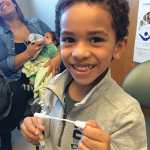Monthly conference calls with site coordinators are essential, says Mieszkalski. “At the beginning of the grant, we focused on CARRA Registry–specific issues. But now that the bulk of our sites are up and enrolling patients, we are spending more time on study coordinator–specific issues that can be useful across all studies. We share best practices and ways to make the not-so-fun parts of research go more smoothly,” she says. Mieszkalski notes that some coordinators are highly experienced, and their ability to share hints, tips, and materials gained over a decade or more of clinical research experience can be invaluable to coordinators who are just starting. “And some of our new coordinators are great idea people, too!” she says.
In June 2011, CARRA will hold its annual meeting in Miami, and this will include a full day of training for study coordinators. Mieszkalski says that, in addition to training, it is hoped that this meeting will foster networking among the coordinators so that they feel free to reach out to one another with the inevitable questions and glitches that arise in daily operations.
“Study coordinators will also have the opportunity to give their own presentations, which can help beef up their CVs. Many coordinators don’t come across the opportunity to do professional presentations. But if they’re open and willing, we want them to have that experience in a supportive environment. They can present on a general research topic, the Registry, or discuss another research project that’s ongoing at their site,” says Mieszkalski.
Coordinators have varied backgrounds, ranging from nurses with years of clinical experience, to recent college graduates, to people with undergraduate degrees and additional certification in clinical research. “I wish we could provide additional financial assistance to study coordinators who want to pursue clinical research certification, but it is expensive to take the exam prep courses and the exam itself, not to mention the cost of maintaining the certification. Right now we don’t have funding to support that,” says Mieszkalski, who notes that people with research certification “often have a better understanding of the regulatory aspects of conducting clinical research.”
Mieszkalski has definite ideas about what she’d like to see in the next five years. “Research coordinators who have experience in pediatric rheumatology at CARRA sites are our best resource. For me, retaining more CARRA study coordinators would be huge, and I would like to see the bulk of people staying.” She also hopes it becomes possible to have at least some of the research coordinators have face-to-face meetings more than once a year. She also notes that there is a move to include research coordinators on the CARRA disease-specific subcommittees, which currently have only physician members.


